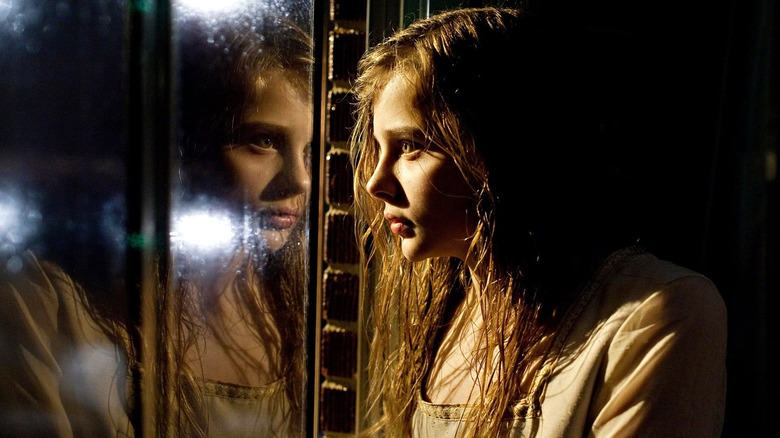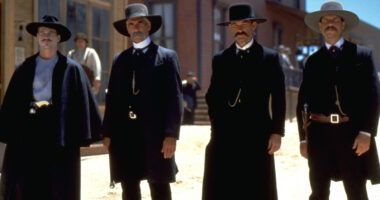Share this @internewscast.com
Stephen King, the maestro of horror, has an appreciation for pop culture and often indulges in creations by others. During his tenure as a columnist for Entertainment Weekly from 2003 to 2011, King shared his admiration for a diverse range of films. In 2010, he unveiled a list of his top 10 favorites, featuring unexpected picks like “Jackass 3D” and “The Social Network.” However, topping this eclectic list was a choice that might surprise some: the haunting film “Let Me In.”
“Let Me In” is a chilling adaptation of John Ajvide Lindqvist’s 2004 novel, which had already been brought to screen in the acclaimed 2008 Swedish film “Let the Right One In.” This particular version unfolds the eerie tale of a young, bullied boy named Owen (Kodi Smit-McPhee) and his mysterious friend Abby (Chloe Grace Moretz), who turns out to be a vampire. King praised the film for its striking contrasts, noting, “Moving and bloodthirsty, tender and horrifying, sweet and gruesome.” He lauded the film’s ability to blend beauty with horror against the stark winter backdrop of Los Alamos, New Mexico, declaring it the best horror film of the decade.
The film kicks off with a gripping scene that leaves viewers on edge—a man, disfigured by acid, is rushed to the hospital. Left unattended, he leaps to his death, setting the stage for a narrative that rewinds to two weeks earlier. In the bleak winter of 1983, Owen encounters Abby as she moves into the neighboring apartment. Despite her initial warning that they cannot be friends, a bond forms between them. Meanwhile, Abby’s “father,” Thomas (Richard Jenkins), is embroiled in a grim task, attempting to procure blood to satiate Abby’s vampire hunger. His failure leads to desperate measures and ultimately, his tragic demise, shedding light on the film’s opening mystery. Owen soon learns the truth about Abby, who demonstrates her loyalty by taking drastic action against his tormentors.
While “Let Me In” retains much of the essence of its Swedish predecessor, there are notable differences. The setting shifts from Stockholm to Los Alamos, and the characters’ names are Americanized from Oskar and Eli to Owen and Abby. Despite these changes, the film retains a distinctly American flavor, underscored by cultural references to the era, including nods to Ronald Reagan.
What is Let Me In about?
Stephen King is no stranger to the vampire genre, having penned several stories that delve into vampire lore. His second novel, “Salem’s Lot,” released in 1975, stands out as a quintessential vampire tale. The novel, ranked 10th on our list of the best Stephen King books, follows the sinister spread of vampirism in the small town of Jerusalem’s Lot, Maine. This chilling narrative has been adapted multiple times for the screen, with the 1979 miniseries remaining a fan favorite, even as newer versions captivate streaming audiences today.
It’s 1983 in the dead of winter when Owen meets Abby. She looks like she’s about his age, and she’s moving into the apartment next door. During that first interaction, she tells him they can’t be friends. The pair quickly become close anyway, regardless of her warning. Meanwhile, Abby’s “father,” Thomas (Richard Jenkins), kills a boy by draining his blood. Instead of bringing any of the precious fluid home to Abby — Thomas is not, himself, a vampire — he accidentally spills it. Hunger forces Abby to drink a neighbor’s blood instead. Thomas later tries again to get blood for Abby, but when he’s about to be captured, he pours acid over himself to at least make him unrecognizable. It’s an act that keeps Abby safe. At the hospital, Thomas lets the girl drink of him before plummeting to his death — that harrowing opening scene now has an explanation. Owen eventually discovers for himself that Abby is a vampire, and his new friend proves her loyalty to him by dismembering his bullies.
While “Let Me In” and its Swedish original share a lot of common traits, there’s some divergences. That’s especially true of the setting, which is Los Alamos in “Let Me In” and Stockholm in the Swedish version. The characters’ names naturally follow, changing from Oskar and Eli in “Let The Right One In” to the American-sounding Owen and Abby in the remake. The two films otherwise remain similar, although “Let Me In” lays in an undertone of unmissable Americana, including references to Ronald Reagan.
Has Stephen King written anything in the vampire genre?
Yes, Stephen King has written multiple novels and short stories in the vampire genre. His most notable work is his second novel, 1975’s “Salem’s Lot,” which is No. 10 on our list of best Stephen King books. In it, Kurt Barlow, an ancient vampire, settles down in Jerusalem’s Lot, Maine, and manages to turn just about everyone in town before the horror is over. The book has been adapted for film and television three times. The best version is still the ’79 miniseries, even though it’s the troubled 2024 version that’s topping HBO Max’s streaming charts.
King also expanded on his vision of vampires in short stories, notably those continuing the “Salem’s Lot” saga. That includes a sequel story, “One for the Road,” and the prequel “Jerusalem’s Lot.” He also introduced vampires (partially via the Lot’s troubled priest, Father Callahan) to his Dark Tower epic during “Wolves of the Calla,” “Song of Susannah,” and “The Dark Tower” itself. King eventually establishes that, in his fictional world, there are different kinds of vamps. They are classified as Type Ones, which are hundreds of years old, Type Twos, which are recently turned humans, and Type Threes, which are infected but not dangerous.
Despite his love for these fanged horrors, King probably could never have written the novel for “Let the Right One In” or scripted its adaptations. The plot is too quiet and contemplative for his more active, rural American style, but that’s no insult. This kind of authorial diversity shows off the narrative flexibility of the vampire. While many readers think of these creatures as fueled by some ancient, relentless evil, they can also be young, innocent, and even genuinely romantic. It’s that complicated potential that makes vampires especially intriguing among movie monsters. “Let Me In” proves that in spades.







